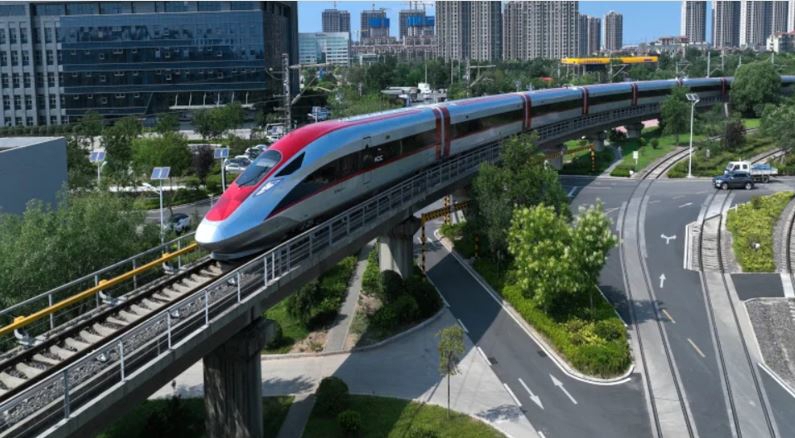The North-South high-speed railway project is considered a strategic infrastructure initiative for Vietnam, running for approximately 1,541 km through 20 provinces and centrally-governed cities and connecting Ngoc Hoi Station in Hanoi and Thu Thiem Station in Ho Chi Minh City. The project will have total investment of an estimated $70 billion.
More than just a key national transportation project, the high-speed rail link is viewed as a symbol of Vietnam’s strong aspiration to modernize its infrastructure, bridge regional development gaps, enhance sustainable transport capacity, and move towards low-emission goals. It is also expected to serve as a strategic catalyst, creating new momentum for economic growth and expanding regional and international connectivity in the context of deepening global integration.
Magnet for international partners
Since the Vietnamese Government officially announced plans to develop the North-South high-speed railway, the project has swiftly emerged as a highly-attractive prospect for major global corporations. With its massive investment scale, long-term growth potential, and a clear policy orientation in Vietnam towards public-private partnerships (PPPs), the project is drawing considerable attention from international stakeholders.
Beyond the keen interest expressed by domestic enterprises such as VinSpeed, under Vingroup, and the Truong Hai Group, a growing number of renowned foreign investors have also signaled their intent to participate in the transformative infrastructure initiative. For many, it represents not only a strategic business opportunity but also a chance to contribute to Vietnam’s broader goals of modernizing transportation, enhancing regional connectivity, and fostering sustainable economic development.
As part of Prime Minister Pham Minh Chinh’s official visit to France in early June, Alstom - one of the world’s leading corporations in rail transport solutions - expressed strong interest in taking part in the project. “Alstom is ready to transfer advanced technology and engage in extensive cooperation with Vietnamese enterprises to help develop a sustainable and self-reliant railway industry in Vietnam,” Mr. Henri Poupart-Laffarge, CEO of Alstom, affirmed.
Within Asia, South Korea, which boasts extensive experience in building and operating high-speed railways, has also demonstrated deep interest in the project. During a meeting with Minister of Construction Tran Hong Minh in late May, Ambassador of South Korea to Vietnam, H.E. Choi Young Sam, noted that South Korean companies are eager to participate not only as investors but also through technology transfer, workforce training, and the localization of locomotive and rolling stock production.
Meanwhile, Japan, renowned for its Shinkansen high-speed rail network, has continued to assert its role as a longstanding partner in Vietnam’s transportation sector. Ambassador of Japan to Vietnam, H.E. Ito Naoki, emphasized the importance of Japan’s cooperation in infrastructure development, particularly in transportation. He confirmed that it is greatly interested and prepared to share its expertise and support Vietnam in undertaking infrastructure projects, including the North-South high-speed railway.
Similarly, the China Communications Construction Company Ltd. (CCCC) has actively followed the project and related rail links between Vietnam and China, placing particular emphasis on the strategic importance of the North-South high-speed rail corridor. The company has also pledged close collaboration with Vietnamese enterprises in sharing, transferring, mastering, and developing technologies within Vietnam’s railway construction and industrial ecosystem.
Beyond international corporations, global financial institutions such as the Asian Infrastructure Investment Bank (AIIB) and the World Bank (WB) have also expressed strong willingness to support and collaborate with Vietnam in bringing the landmark project to life in the near future.
These institutions have indicated their readiness to provide financial support, technical assistance, and policy advice to help ensure the project’s feasibility, transparency, and long-term effectiveness. Their involvement would also play a critical role in attracting additional private sector investment and reinforcing international trust in Vietnam’s infrastructure development strategy.
International cooperation pivotal
The surge of interest from leading global corporations in Vietnam’s North-South high-speed railway project is more than just a sign of the country’s growing attractiveness as an infrastructure market, it also underscores the indispensable role of international cooperation in the successful realization of complex, large-scale mega-projects.
With estimated investment nearing $70 billion and rigorous technical requirements, the project calls for more than just substantial capital. It also demands deep expertise, advanced technology, and a highly skilled workforce - resources that can be effectively mobilized through partnerships with experienced international players.
Minister Minh has emphasized the strategic value of these partnerships, noting that international involvement will be crucial to the project’s success. For example, he highlighted South Korea as a noteworthy case, pointing to its high-speed railway system that boasts a localization rate of over 90 per cent in rolling stock and locomotive production. “This can offer a model that Vietnam could follow to master key technologies, reduce dependency, and gradually increase its self-reliance in implementing similar large-scale infrastructure projects,” he noted.
Though Vietnam has yet to finalize investor selection for the project, the strong interest from a broad spectrum of respected international corporations signals a wealth of opportunities. It allows the government to carefully evaluate and choose partners not only based on financial strength but also on long-term commitment, readiness to transfer technology, and the ability to ensure operational excellence.
The alignment between Vietnam’s strategic ambitions and the hands-on experience of global partners is expected to serve as a driving force for the successful delivery of the high-speed railway.
Mr. Nguyen Quoc Hiep, Chairman of the Vietnam Association of Construction Contractors (VACC), echoed this view. He noted that the project is seen as one of the largest infrastructure undertakings in Vietnam’s history, presenting both a significant opportunity and a formidable challenge for Vietnamese contractors.
Given the project’s scale, technical complexity, and demanding schedule, it requires robust organizational capacity, state-of-the-art construction equipment, strict quality control, and adherence to international standards. In this context, Mr. Hiep stressed the importance of international collaboration, asserting that such partnerships would allow Vietnamese companies to access cutting-edge technologies, adopt modern project management practices, and gain valuable experience from countries that have successfully built and operated high-speed rail networks.
He further emphasized that international cooperation would bring not only technical and operational benefits but also financial and human capital support, ensuring both timely progress and high investment efficiency. Over time, such collaborations could help domestic firms build capacity, increase the localization of materials and workforce, and enhance their competitiveness in future infrastructure projects.
However, Mr. Hiep also made clear that international participation must be structured to empower local companies. “In cases where foreign contractors wish to participate, they must form joint ventures with Vietnamese contractors, with the Vietnamese side responsible for at least 50 per cent of the total workload,” he proposed.
Along with that, he also suggested that workforce policies prioritize local employment. “The use of Vietnamese workers should be a requirement, with at least 70 per cent of the workforce coming from within the country,” he said. “This approach would not only create economic benefits for local communities but also help nurture a skilled workforce capable of supporting Vietnam’s long-term infrastructure ambitions.”









 Google translate
Google translate